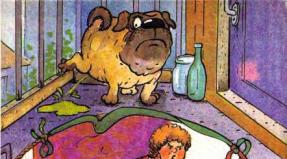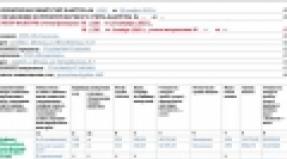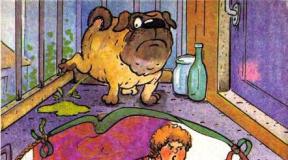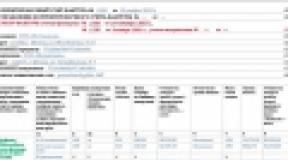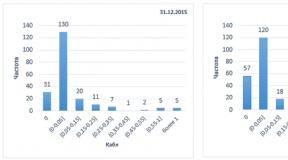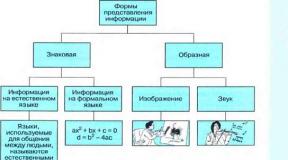Treatment regimen for atopic dermatitis in infants. How to recognize atopic dermatitis in infants: photos of manifestations, advice to parents, rules for treatment and prevention of relapse of the disease. Clinical manifestations of atopic dermatitis
One of the childhood illnesses that causes concern among parents is atopic dermatitis in infants. The disease has age-related differences. Pathology in a newborn and a one-year-old child occurs differently. Let's look at the characteristics of the disease in children from birth to one year.
What it is
Atopic dermatitis in infants is based on allergic inflammation. This chronic disease, associated with changes in the functioning of the immune system, takes a long time to pass. Irritants act on the infant from the external environment and are located in the baby’s body.

Allergens trigger the pathological process. Under their influence, a focus of inflammation appears in which pathogenic cells accumulate. They secrete biologically active substances that support inflammation even after the allergen is removed.
Skin infections increase allergic pathology: coccal, fungal, etc. Hence the need arises for persistent and long-term anti-inflammatory therapy in all atopics, especially in infants.
Causes of atopic dermatitis in infants
A large number of factors have been identified that can individually or in combination cause atopic dermatitis in infants. The main reason for the development of the disease in newborns is heredity.
Atopic eczema in a weak baby’s body also occurs for the following reasons::
- severe pregnancy, viral infections suffered by the woman;
- treatment of the baby and mother with medications;
- the use of aggressive household chemicals in the process of caring for a baby;
- food products for mother and child;
- violation of personal hygiene rules;
- failure to comply with the requirements for the room in which the baby is kept.
Contact atonic dermatitis in infants is caused by clothing made of synthetic fabric, pollen, pet hair, and household dust. Intestinal dysbiosis and infectious diseases can also cause allergic dermatitis.
The most common cause of eczema in infants is poor nutrition. Dr. Komarovsky notes that a painful condition in a baby occurs when the mother’s diet changes.
Products, causing atopic dermatitis in infants, there may be low-quality mixtures, cow's milk, eggs, etc.
Has special features atopic dermatitis complicated by Staphylococcus aureus.
In this case, the infant has:
- brown rash on the face, behind the ears, on the neck under the chin, in the armpits, back and groin;
- blisters on the body, detachment of the upper layer of the epidermis;
- elevated temperature;
- signs of general malaise.
Atopic dermatitis, as a result of the action of staphylococcus bacteria, develops very quickly, within one to two days. The disease most often occurs in babies who developed abnormalities and delays in the womb. Late toxicosis in the mother and the baby’s long stay without water during childbirth also cause staphylococcal dermatitis.
Diagnostics
If a rash appears on the baby's skin, parents should immediately consult a doctor.
Important!
Under no circumstances should you self-medicate your baby. Only a pediatrician will take the right steps to eliminate the disease.
The doctor will examine the newborn, pay attention to what the baby’s skin looks like, talk with the mother, determine the causes of inflammation on the skin, and refer you to an allergist.

To clarify the diagnosis, the following examinations may be prescribed::
- general and biochemical blood test;
- allergy tests and samples;
- analysis for staphylococcus and dysbacteriosis.
The test results will help determine the substance that caused childhood eczema and prescribe the necessary treatment.
Atopic dermatitis in infants - video
How to treat atopic dermatitis?
 It takes at least two to three months for the signs of the disease to disappear. Parents need to be patient, follow the doctor’s recommendations, and adjust the prescriptions together with the doctor.
It takes at least two to three months for the signs of the disease to disappear. Parents need to be patient, follow the doctor’s recommendations, and adjust the prescriptions together with the doctor.
Related article:
Inflammation of the anus - perianal dermatitis. Symptoms, treatment and photos
Otherwise, the inflammatory process will take an irreversible form and subsequently cause bronchial asthma, allergic rhinitis and other serious illnesses in a person.
Doctors have developed general approaches to the treatment of atopic dermatitis in infants:
- It is necessary to eliminate contact with allergens.
- Follow a special diet.
- Take antihistamines to relieve the patient from itching.
- Remove toxins from the body.
- Take anti-inflammatory drugs.
- Use sedatives.
Treatment with medications
 Neurodermatitis must be treated comprehensively. Medicines are prescribed taking into account age, stage of the disease and location of the rash. If necessary, sorbents, creams, vitamins, immunomodulators, antiseptics, antihistamines and antibacterial drugs are used.
Neurodermatitis must be treated comprehensively. Medicines are prescribed taking into account age, stage of the disease and location of the rash. If necessary, sorbents, creams, vitamins, immunomodulators, antiseptics, antihistamines and antibacterial drugs are used.
Preparations for internal use
To remove toxins from the body, doctors often prescribe Enterosgel sorbent. A safe and useful drug that removes allergens from the body is Smecta suspension.
Doctors often use Fenistil and Zyrtec as an antihistamine. If coccus bacteria are detected on the skin of a newborn, antibiotics are used together with bifidumbacterin. Immunomodulators and vitamins are rarely used for infants.
Dr. Komarovsky strongly recommends giving babies calcium gluconate. Deficiency of this substance in infants occurs during the period of growth and appearance of teeth. Then atopy worsens. The use of calcium gluconate will help cope with exacerbation of allergic diseases.
Products for topical use
Creams and ointments play an important role in the treatment of eczema in infants. They relieve irritation, moisturize, restore and nourish the skin. In acute cases, a hormonal ointment based on glucocorticoids is used.

 The cream has become widely known for atopic dermatitis in children. Emolium. For local treatment of inflamed skin, pharmacies have lipolotion and hydrolotion Excipial m. These non-hormonal lotions effectively treat and protect irritated skin of various types.
The cream has become widely known for atopic dermatitis in children. Emolium. For local treatment of inflamed skin, pharmacies have lipolotion and hydrolotion Excipial m. These non-hormonal lotions effectively treat and protect irritated skin of various types.
A good product for dry skin is Mustela brand cream. They are advised to lubricate the baby's skin after bathing. The product penetrates deeply into the skin, softens it, and relieves irritation.
Important! Please read the instructions before using baby care products.
Treatment with traditional medicines
It is impossible to cure atopic dermatitis with traditional medicines.. Creams and ointments prepared according to folk recipes are used in infants to ease the course of the disease.
Soothe itchy skin:
- a compress of finely grated raw potatoes;
- lotions made from prepared black tea;
- warm baths with the addition of flax seed.
Atopic dermatitis is a common, persistent skin disease that affects a large number of people around the world. Atopy is a special type of allergic hypersensitivity that is also associated with asthma and hay fever.
Although the disease can occur at any age, it most often affects infants and young children. 60% of patients are children under one year old. At the same time, there are periods of exacerbation and remission, when the skin condition improves and unpleasant clinical manifestations go away. With age in children, the disease can practically disappear, leaving only dryness and irritation of the skin.
Causes, symptoms
The cause of atopic dermatitis is unknown, but the disease appears to result from a combination of genetic and environmental factors. Patients with dermatitis have a defect or insufficient amount of filaggrin protein, which regulates skin hydration. People with atopic dermatitis are predisposed to developing athlete's foot and staph or streptococcal skin infections. The disease can be inherited.
Dermatitis in infants usually appears in the face, behind the ears, and on the head. If left untreated, it can spread to the elbow, popliteal and groin areas.
Atopic dermatitis is characterized by the following skin changes:
- The baby's skin becomes very dry, rough, and there are signs of inflammation (redness, swelling).
- The skin begins to itch, cracks, crusts, and blisters may form that burst, and the skin begins to become wet.
- There are dry scales on the surface of the legs.
- The number of folds on the palms has increased.
- Dark circles appear under the eyes and the eyelids become pigmented.
The development of atopic dermatitis is associated with certain factors that affect the child and cause clinical manifestations:

Principles of therapy
Treatment of atopic dermatitis is complex. In addition to medications for systemic and local use, folk methods are effective. You can cure the disease or speed up the recovery process by following basic rules for caring for a child prone to atopy.

Drug treatment
Antihistamines are used among medications for the treatment of atopic dermatitis. They help relieve itching and signs of inflammation in the affected skin area. Atopic dermatitis in children under one year of age can be treated with the following medications:
- Fenistil and Zyrtec in the form of drops.
- Fenkarol in powder form.
 Zyrtec is a second generation antihistamine. Feedback from mothers when using this product is positive, as it does not have a sedative effect. After taking Zyrtec, the child is active, itching and hyperemia on the skin quickly disappear. Used once during the day. Recommended for use in children over 6 months.
Zyrtec is a second generation antihistamine. Feedback from mothers when using this product is positive, as it does not have a sedative effect. After taking Zyrtec, the child is active, itching and hyperemia on the skin quickly disappear. Used once during the day. Recommended for use in children over 6 months.
Treatment of dermatitis in newborns should be strictly under the supervision of medical personnel. Before using the drug, you should consult with your doctor, who will select the correct dosage.
Local treatment
Dermatitis can be treated with topical medications. Preference is given to antihistamines. One of the most common is Fenistil-gel. It has an antiallergic effect, helps relieve itching, signs of inflammation, and is applied to the skin 2-3 times a day in a thin layer.
Ointments containing glucocorticosteroids are sometimes used to treat dermatitis.. They quickly relieve symptoms, but are strong remedies with many side effects. The use of hormonal ointments is not recommended for children under one year of age. They are prescribed for severe atopic dermatitis.
A child from 6 months can use Lokoid or Advantan ointment, but strictly as prescribed by the attending physician.
Folk remedies
Traditional methods are effective and widely used to treat dermatitis in infants.


Nutrition for a nursing mother
Some foods can cause dermatitis in newborns. Allergens penetrate through breast milk, so it is important for a nursing mother to follow a diet.
The following should be excluded from the diet:
- products with chemical additives and dyes;
- citrus;
- cow's milk;
- egg whites;
- chocolate;
- nuts;
As the child grows, these products must be carefully introduced into the baby’s diet, added one at a time and monitored for the occurrence of an allergic reaction.
Hello dear readers. The topic of our discussion today will be atopic dermatitis in infants.
We will talk about the main symptoms and methods of treating AD with medications and folk remedies.
Atopic dermatitis in infants
Atopic dermatitis (AD) is not so much a skin disease as a manifestation of problems in the body.
Inflammatory lesions of the skin - atopic dermatitis - are triggered by allergens that can enter the child's body through food, contact or air.
Atopic dermatitis in infants, children or adults is a chronic disease.
In addition, hay fever () and bronchial asthma may develop.
Symptoms of atopic dermatitis in infants
How to recognize the disease? Symptoms of atopic dermatitis in infants may appear and disappear. Therefore, pay attention to the following skin problems:
- Redness and dryness of the skin;
- Peeling of the skin;
- Diaper rash that does not go away for a long time;
- Milky crust on the scalp;
- Weeping areas of skin.
Typically, symptoms of atopic dermatitis in infants appear after:
- consumption of allergenic foods by a child or nursing mother (eggs, honey, etc.);
- using aggressive detergents to wash baby’s clothes or bathe with soap for adults;
- using room freshener sprays in the room or as a reaction to deodorant or parental perfume.
Atopic dermatitis in infants can be recognized from the photos given in the article. These are the most common types of skin manifestations of the disease.

Treatment of atopic dermatitis in infants
Depending on the complexity of the disease, the pediatrician may prescribe medications that will help alleviate the child’s condition.
Medicines can be used in the form of an ointment or orally - tablets or syrup.
Do not hesitate to ask your doctor questions regarding the method of use, dosage or possible replacement of medications with folk remedies.
The most commonly prescribed over-the-counter medications are:
- Local topical steroids relieve itching and reduce inflammation. Such medications include, for example, hydrocortisone ointment.
- local purpose. These may be alcohol-containing drugs; they can cause a burning sensation on the baby's skin.
- Oral antihistamines. They relieve itching, but make the child drowsy.
In more complex cases, the pediatrician may prescribe medications that are available only by prescription:
- Topical steroids. Safe drugs that relieve inflammation and itching. It is important to follow the dosage, otherwise side effects may occur.
- Nonsteroidal drugs are local immunomodulators. An effective new generation product. Can only be used from 2 years of age.
- Oral antibiotics are prescribed if a secondary infection occurs.
- Steroids are prescribed in particularly difficult cases, extremely rarely. These medications cause various exacerbations.
Treatment of atopic dermatitis in infants with folk remedies
Herbal medicine is a fairly effective remedy in the fight against the manifestations of atopic dermatitis.
However, you should be careful when choosing medicinal herbs. Some of them can cause the baby's rash to worsen.
The most popular way to treat infants with folk remedies is considered to be baths and lotions or topical ointments.
Here are some popular bath recipes:
- Add birch bud infusion to your bath. It is prepared as follows: 1 tablespoon of dry buds in 1 glass of boiling water is infused in a thermos for 3 hours. The infusion is filtered and added to a bath filled with water.
- Nettle, burdock root, violet herb, yarrow. 120 grams of any of the herbs are poured into 1 liter of boiling water and infused in a thermos. Add the required amount of infusion to the bath.
- Baths with a small amount of sea salt are also very useful. It is recommended to take a course consisting of 10-15 baths daily or every other day.
- A bath with added starch perfectly relieves itching. Dilute 30-50 grams in a small amount of hot water and pour into the bath.
- Acceptance time is 15-20 minutes.
- Water temperature – 36-38oC.
- At the end of the procedure, the skin should be blotted with a towel and lubricated with baby cream.
In addition to baths, good remedies are:
- Lotions with raw potato juice or aloe juice. You just need to apply the product to the inflamed areas of the skin.
- Ointment based on propolis and vegetable oil. Both ingredients must be combined in a container and heated in the oven until a uniform brown color is formed. The finished ointment is better preserved in a dark glass container.
In order to disinfect atopic areas of the skin, it is good to use extracts of basil, thyme, burdock, licorice and some other medicinal plants.
Important to remember
- Atopic dermatitis in infants is triggered by allergens entering the body, so it is important to take the necessary preventive measures.
- AD is a chronic disease. Periods of exacerbation are followed by remission, so be attentive to the symptoms of the disease and do not delay a visit to the pediatrician.
- Atopic dermatitis of infants can be treated with medications and folk remedies. However, in both cases it is important to follow the pediatrician’s recommendations so as not to harm the baby.
See you in the next article!
For every mother, the most valuable thing is the health of her baby. Unfortunately, many parents have to deal with problems at the very early stages of a child’s growth and development. One of the diseases that manifests itself very early and causes a lot of trouble for both mothers and babies is atopic dermatitis.
What is atopic dermatitis?
Pathology is the most common manifestation of a child’s body’s hypersensitivity reaction to the allergens that surround it. Atopic dermatitis accounts for about 80% of all cases of allergic reactions in children. Usually the disease manifests itself in the youngest children - in the first year of life, and is chronic, with periodic exacerbations and remissions. In most cases, skin manifestations of the disease disappear by 4–5 years, but can persist into adolescence and even into adulthood. Very often, starting with skin lesions, atopy manifests itself with the further addition of allergic diseases: rhinitis, conjunctivitis, urticaria, bronchial asthma. Babies often have a bacterial or fungal infection.
Atopic dermatitis is a disease caused by genetics and manifests itself with characteristic skin rashes. The disease is based on an incorrect, perverted response of the immune system to internal and external stimuli.
The name of the disease has many synonyms - exudative diathesis, atopic eczema, endogenous eczema, neurodermatitis, Beignet's prurigo, diathesis prurigo.
Despite the fact that the disease is classified as allergic, atopy and allergy are still different concepts. An allergic reaction in a person occurs to a small dose of the same allergen (or several), and this condition lasts a lifetime. An atopic response develops to many allergens, and with age this “assortment” may change or disappear completely, and the immune response also changes depending on the amount of allergen (a small dose may not cause the development of atopy at all).
Genetics plays a leading role in the occurrence of atopy. For example, if both parents suffer from allergic diseases, then the risk of atopic eczema in the baby is very high and is 85%, and if one of the parents, then the probability of developing the disease is 50 to 50.
The pathology manifests itself as dryness, redness and rashes on the baby’s skin, usually in certain places. Over time, weeping eczema forms in these places, which is very itchy and causes a lot of anxiety to the child. As a rule, the first manifestations of the infant form of atopic dermatitis (from 0 to 3 years) debut at two months of age; the child begins to feel severe itching at 3 months.
Classification
The stages in the development of the disease are:
- initial manifestations;
- pronounced changes;
- remission;
- clinical recovery.
In children under one year of age, foci of atopic eczema are localized, as a rule, on the face (cheeks, chin, forehead), and on the scalp in the scalp. In older children (from 2 years old), the outer sides of the limbs, the areas of the bends of the arms and legs are usually affected; in the same places, newborns and infants can also have rashes.
According to the degree of prevalence, the disease can be:
- limited (foci on one side of the body);
- disseminated or widespread (foci of eczema in two or more areas);
- diffuse (almost the entire surface of the skin is affected).
Along the way, the disease can be:
- light;
- moderate severity;
- heavy.
Pathology can occur in three forms:
- eczematous (exudative);
- erythematous-squamous;
- lichenoid.
In the smallest children of 2–3 months of age, the disease manifests itself in an erythematous-squamous form: the skin is hyperemic, severely flaky, and there are many small papules (nodules). The rash is accompanied by severe itching and is localized on the bends of the elbows and knees, cheeks, neck, and hands.
The eczematous form develops at six months of age and is manifested by hyperemia, lamellar peeling, a rash in the form of papules (nodules) and vesicles (small blisters), which burst, become covered with crusts, the surface under which may bleed. The affected areas are first the cheeks, then the hands, elbows, and popliteal folds.
The lichenoid form is diagnosed at an older age - in adolescents and adults.
Causes and provoking factors in infants
The cause of atopic rashes is an immune response to the introduction of allergens, determined by the genetics of the child.
Factors provoking the development of the disease:
- Unfavorable environmental situation (air and water pollution, consumption of products with GMOs, food additives).
- Pregnancy pathologies, poor nutrition of the expectant mother, her bad habits.
- Early transfer of the baby to artificial feeding, especially with low-quality formulas. In addition to the quality of the mixture, the method of feeding plays a role. Bottle feeding contributes to overfeeding the baby, since it is much easier and faster to absorb formula through the nipple than to suckle at the breast. It is overfeeding (an overdose of protein, and not the protein itself contained in formula and milk) that causes the development of atopic eczema. The baby’s enzyme system is unable to cope with a large amount of food; “extra” proteins become toxins.
- Frequent infectious and viral diseases contribute to sensitization of the body.
- Incorrect use of immunomodulators, which can lead to changes in the normal immune responses of the child’s body.
- Lack of nutrients, vitamins, microelements in the mother's diet, if the baby is breastfed, a deficiency condition occurs.
- Incomplete development of the baby's gastrointestinal tract (digestive tract) or pathological conditions (dysbacteriosis, lack of enzymes, diseases of the pancreas, liver) contribute to the fact that the protein components of food cannot be absorbed, are not excreted from the body and turn into allergic agents.
- Helminthic diseases cause damage to the digestive organs and intoxication, which provokes a peculiar immune response in the form of atopy.
Excess salt and sugar in the mother’s diet if the baby is breastfeeding, or in baby food when the baby is already feeding. Sugar and salt cause fermentation processes in the intestines and disrupt the process of normal protein absorption; salt also enhances the absorption of allergens.
The structure of the baby's skin is a very important factor. The epidermis of babies is very thin, it peels off easily, but at the same time it fulfills its function - removing harmful substances from the body through sweat. The thermoregulatory function in young children is even reduced; babies easily overheat if they are wrapped up too much. If the child is insufficiently cared for, he often sweats, the skin is dirty, diapers are rarely changed, the clothes are made from low-quality unnatural fabric, the baby is in a hot room with dry air, then the lipid layer of his skin is destroyed, the skin becomes overdried and extremely vulnerable. This leads to the fact that the baby is open to external influences of toxins, allergens, chemical compounds, bacteria, fungi, etc. With any contamination or exposure to allergens, atopy appears on the skin. On the other hand, if the child’s skin is constantly covered with a thick layer of baby oil or cream, and the child sweats, then its respiratory and excretory function is disrupted, and atopic eczema appears.
The immune response of the child’s body occurs to foreign agents, which can be:
- endogenous (internal) - own biological structures are sometimes perceived by immunocompetent cells as foreign and a reaction occurs with the subsequent development of an autoimmune disease;
- exogenous (external) allergens:
- biological - bacteria (staphylococci, streptococci), viruses, fungi (mold), helminths, vaccines;
- medicinal;
- food - protein products or containing haptens (molecules that acquire the properties of an allergen when attached to a carrier protein);
- household - clothing, care products, household chemicals, dust;
- natural - pollen of flowering plants, animal hair, insect bites;
- industrial - chemical compounds, solvents, gasoline, paints, varnishes;
- physical - high or low temperature, dry air, solar radiation, wind.
The allergen can enter the child’s body through food, through the respiratory tract, skin, or through injections of medications. In babies under one year of age, food allergies are prevalent.
Video - Doctor Komarovsky about atopic dermatitis
The most common allergens are the following products:
- cow's milk protein;
- chicken eggs;
- Fish and seafood;
- legumes;
- Wheat flour;
- fruits and berries:
- citrus fruits, grapes, currants, peaches, apricots, raspberries, strawberries;
- vegetables:
- tomatoes, carrots, potatoes, beets;
- honey, propolis;
- nuts;
- sweet pastries, chocolate, candies;
- meat:
- duck, pork, chicken;
- any spices, large amounts of salt and sugar;
- medications:
- antibiotics of the tetracycline and penicillin group, Aspirin.
Video - Doctor about atopic dermatitis
Symptoms of the disease
The infant form is manifested by acute inflammation of the skin - swelling, redness, the appearance of nodules and small blisters that open and become wet, erosions, crusts and peeling form. The initial manifestations of atopic eczema are gneiss (scales resembling seborrhea in the area of the large fontanel, eyebrows and behind the ears), milky scab - erythema (severe redness caused by the dilation of small vessels) with dark yellow crusts. The skin rash is accompanied by a burning sensation, severe itching, the child scratches the affected areas, because of this, an infection can occur and pyoderma may develop.
With proper treatment, eczema heals, erythematous lesions lighten, and pigmentation may remain. The period of exacerbation is followed by remission, which can last a long time - months.
Diagnosis and differential diagnosis
The diagnosis is made by a pediatric dermatologist and allergist. Doctors examine the child, assess the condition of the skin, conduct a medical history (questioning the parents) and conduct a laboratory examination.
Specialists must check whether there are hereditary allergic diseases in the family, when and what symptoms the disease first appeared, how it progresses (with exacerbations and remissions), the child’s dependence on climatic conditions, living conditions, the presence of pets, the peculiarities of the mother’s diet (including case of breastfeeding) and the child (what formulas are fed, when and what complementary foods were introduced), how hygienic care of the baby’s skin is carried out.
Laboratory diagnostic methods:
- A blood test for Ig E (immunoglobulin E) determines its elevated level (the more severe the symptoms of eczema, the higher the Ig E level).
- A clinical blood test shows a slight increase in leukocytes, a high level of eosinophils, and an acceleration of ESR. Such indicators indicate an inflammatory and allergic process in the body.
- The immunogram shows changes in the indicators of the main components of immunity.
Other tests are needed to determine the general condition of the child’s body and determine the possible causes of the disease:
- biochemical blood test to assess the functionality of the kidneys and liver;
- clinical urine test to determine kidney condition;
- stool analysis for worm eggs and coprogram for identifying helminths and dysbacteriosis.
The disease must be differentiated from the following pathologies: pityriasis rosea, seborrheic dermatitis, scabies, microbial eczema, psoriasis.
Treatment
Treatment of the disease must be comprehensive. It is necessary to completely eliminate allergens that cause atopy (from food and everyday life). Therapy includes local treatment of the skin with medications, special care for the baby’s skin, as well as systemic medications.
Medicines
Various forms of external agents are used depending on the clinical course of the disease:
- for acute cases, agents with a drying effect are used - solutions, pastes, aerosols, lotions; gels, lotions, emulsions - convenient forms for treating the skin on the scalp;
- fatty ointments and creams are used for subacute and chronic disease.
Anti-inflammatory pastes, ointments, mash should be applied to the affected areas:
- zinc preparations (Zinc-salicylic paste, Zinocap);
- Elidel cream (from 3 months);
- Skin-Cap (cream, shampoo, aerosol);
- Panthenol, Bepanten, Dermopanten;
- tannin solution.
Before applying creams and ointments, it is advisable to treat erosions with antiseptic agents:
- Fukortsin;
- an aqueous solution of methylene blue;
- Chlorhexidine.
During an exacerbation, it is impossible to do without the use of hormonal external agents (topical hormones). Usually they start with drugs of class 1 and 2 (the weakest): Hydrocortisone ointment, Lokoid, Afloderm, if the desired effect is not observed, they switch to stronger drugs of class 3: Advantan. These remedies relieve inflammation and itching. In particularly severe cases, systemic corticosteroids are used under the supervision of a physician.
If a secondary infection occurs, the following is added to therapy:
- antibacterial agents for external use or combined agents (antibiotic plus antifungal, hormone):
- Sibicort, Pimafucort, Triderm, Celestoderm;
- for the treatment of fungal infection:
- Clotrimazole, Exifin, Ifenek;
- herpetic:
- Acyclovir, Gerpevir.
External antihistamines are prescribed: Fenistil gel, Psilo-balm. In case of severe atopic eczema and a large area of damage, antihistamines are prescribed orally:
- Fenistil in drops (from 1 month);
- Cetirizine, Zyrtec (from 6 months under medical supervision);
- Suprastin (injections).
Calcium gluconate is indicated, since calcium deficiency provokes the development of allergic reactions. To remove toxins from the intestines, Polysorb, Enterosgel, Sorbogel, Smecta, and B vitamins are used. Constipation should not be allowed in the baby; lactulose preparations (Duphalac, Normaze) are prescribed for timely bowel movements. If a nursing mother experiences constipation, then this factor must also be eliminated, as it contributes to the development of atopy in the baby. Mom can be advised to take Lactulose, glycerin suppositories, and eat enough fresh fermented milk products.
Photo gallery - Drugs for the treatment of atopic dermatitis
Elidel effectively relieves inflammation in atopic dermatitis. During exacerbation of atopic dermatitis, the drug Advantan, containing the corticosteroid Phenosil, is used externally - the safest drug for the treatment of allergies in young children. Hydrocortisone ointment is a class 1 corticosteroid and is used to treat mild forms of atopy. Bepanten cream has an anti-inflammatory, moisturizing effect. , regenerating effect An aqueous solution of methylene blue is used to treat erosions before applying the drug Skin-Cap is used in various forms: aerosol, cream Duphalac is a mild laxative used for the prevention and treatment of constipation in a child with atopic dermatitis  Enterosgel is not suitable for atopic dermatitis to remove toxins from the intestines
Enterosgel is not suitable for atopic dermatitis to remove toxins from the intestines
It is necessary to eliminate factors that may contribute to infection in scratches: cut the baby’s nails short, wear undershirts with sewn-up sleeves at night, cleanse the skin with neutral baby soap, use emollient hypoallergenic cosmetics for children.
A very important point in the treatment of atopic dermatitis is the elimination of contact of the baby’s skin with factors that contribute to the development of the disease. To do this you need:
- boil water for bathing or put a filter on the water (chlorine is a strong allergen);
- use special baby powders, do the last rinse in boiled or filtered water;
- all children's clothing in contact with the baby's skin must be dye-free (white) and 100% natural - cotton or linen;
- use soap and shampoo only for children, use no more than once a week, so as not to destroy the protective lipid layer on the skin;
- after daily mandatory bathing, do not wipe, but blot the child’s skin and immediately apply a moisturizing cream or lotion (on the entire skin, not just the rash areas), for example, Exipal lotion;
- use high-quality toys from well-known manufacturers;
- wash toys daily with 2% soda solution.
In addition, it is necessary to ensure that the air in the room is humidified and fresh. The skin with atopic dermatitis must be moisturized with special products; they are used in the form of creams, lotions, soaps, gels daily for hygienic care: Mustella, Atoderm, Oilatum, Topicrem, Bioderma Atoderm, A-Derma, Dardia.
The use of emollients (moisturizers) should be constant. We must remember that lotions and emulsions have less moisturizing effect than creams and ointments. The products are applied daily, if necessary - twice a day, after bathing - always.
Diet of a nursing mother
The diet of a mother who is breastfeeding should be hypoallergenic for the entire period of feeding the baby. Fried, salty, fatty, spicy, rich fish and meat broths, canned food, smoked meats, foods containing possible allergens (citrus fruits, legumes, coffee, seafood, nuts, chocolate, honey), as well as preservatives and dyes are excluded.
Complementary foods are introduced to the baby very carefully, under the supervision of a pediatrician, each new product with an interval of at least 2 weeks and careful observation of the child’s reaction. During the period of exacerbation (fresh rashes and weeping eczema), complementary foods cannot be introduced to the child.
If the child is bottle-fed, preference should be given to hypoallergenic formulas:
- soy:
- Frisosoy, Enfamil soy, Humana SL, Bona soy, Tuteli soy;
- based on protein hydrolyzate (with split protein):
- Frisopep, Nutrilon Pepti TSC, Alimentum, Nutrilak Peptidi SCT, Damil Pepti, Nutramigen, Alfare, Pregestimil Hipp GA (for mild atopy);
- based on goat milk:
- Nanny;
- based on amino acids:
- Neocate LCP, Alphare Amino;
- fermented milk:
- Gallia Lactofidus, Hipp with lactobacilli, Agusha fermented milk, Nan fermented milk.
The mixture is selected individually for the child by a pediatrician. For children with atopy, hypoallergenic cereals based on rice, buckwheat, and corn produced by Humana, Heinz, and Remedia are recommended.
Physiotherapy
Physiotherapeutic treatment is aimed at relieving inflammation and stimulating regenerative processes. For the treatment of atopic dermatitis, especially severe forms, it is advisable to use PUVA therapy, UVA irradiation (phototherapy), oxygen barotherapy (treatment with air with high oxygen pressure), and climatotherapy.
Folk remedies
Herbal treatment for atopic dermatitis should be used with caution, since any plant can cause an allergic reaction in a child or undesirable consequences in the form of even more dry skin. For example, chamomile infusion can only be used as a lotion for weeping eczema, and not for baths, since this plant has drying properties.
Pediatricians often recommend bathing your baby with a decoction of bay leaves or oatmeal infusion added to the bath. Bay leaves (10 large leaves) need to be poured with a liter of water, boiled in a water bath for 10 minutes, and added to a bath of water for bathing.
You can also use this product to wipe the affected skin. Pour a glass of boiling water over several leaves (6–8) and leave for 2 hours. Take 2 tablespoons of the resulting infusion and add 1 tablespoon of glycerin, boil in a water bath for 5 minutes. Lubricate the affected areas (in the subacute period) twice a day.
Traditional medicine advises using tar soap to treat atopy. Mothers of babies with atopic dermatitis who have risked using this bathing product note its effectiveness. However, you need to remember that you cannot use products with birch tar in case of secondary infection of the skin, or in case of exacerbation of the pathological process.
Baths with infusion of birch buds (1 tablespoon per glass of boiling water) or with a herbal mixture of burdock roots, yarrow and violet (2 tablespoons per 500 ml of water) soften the symptoms of dermatitis.
If you decide to try one of the methods of traditional medicine, you must first consult with a pediatrician or dermatologist about its safety and feasibility.
Complications and consequences of pathology
Manifestations of the disease may decrease over time or disappear completely. If dermatitis does not go away by 4–5 years, then its symptoms will recur throughout life. The disease has an unfavorable prognosis if it has a very early onset (up to 2 months), a severe clinical course, or is combined with another allergic disease.
A complication of atopic dermatitis is a secondary infection - bacterial, fungal, viral.
Contraindications
The disease imposes certain restrictions on the lifestyle of mother and baby:
- Do not use alkaline bathing agents or allow the water to be too hot;
- you need to protect the child from direct sunlight;
- You should not wash your child frequently; it is better to use baby wipes;
- the crusts that form during the period of exacerbation cannot be torn off and soaked.
Prevention
Primary preventive measures include maintaining a healthy lifestyle and proper nutrition for the expectant mother, as well as during breastfeeding.
Secondary measures should be aimed at preventing exacerbations: following a diet, eliminating provoking factors, proper daily care of the baby’s skin with sufficient hydration, treatment of diseases of the digestive system, maintaining optimal conditions in the house (cleanliness, humidity, fresh air).
Video - Experience in the treatment of atopic dermatitis in infants
Reading time: 6 min.Rashes on a child’s skin are one of the most common reasons why parents turn to a pediatrician. A child’s skin in the first year of life is very thin and sensitive, so rashes can be either a manifestation of common heat rash or a symptom of a number of more serious diseases, each of which has its own characteristics. To protect your child from further complications, you need to know how dermatitis occurs, why it is dangerous, and how to treat it.
Dermatitis in newborns (infantile eczema) is a set of processes of inflammatory and allergic origin that occur against the background of sensitization (hypersensitivity) of the child’s body to all kinds of irritating substances that surround it. The impact of these agents (physical, biological or chemical) on the child’s body leads to a typical manifestation of dermatitis - a rash. Elements of the rash can be localized on different parts of the body: on the baby’s neck, on the face, on the stomach or limbs. As a rule, dermatitis is first detected in infants and children under one year old. The first cases of dermatitis detected in preschool age are very rare.
Why may dermatitis appear in an infant?
The sensitivity of infants to various environmental factors is determined, first of all, by the anatomical and physiological characteristics of the skin and immune system. In the first year of life, the skin does not perform protective and thermoregulatory functions well enough, and the immune system synthesizes antibodies in insufficient quantities (especially class A immunoglobulins, which protect the mucous membranes and skin).
 The combination of the above features leads to the fact that at an early age, children quite often develop various types of dermatitis. People are accustomed to calling any dermatitis “diathesis”, but this is a mistaken opinion. Diathesis is not even a disease, but just a type of constitution that leads to certain developmental characteristics and includes the concept of a child’s predisposition to certain diseases.
The combination of the above features leads to the fact that at an early age, children quite often develop various types of dermatitis. People are accustomed to calling any dermatitis “diathesis”, but this is a mistaken opinion. Diathesis is not even a disease, but just a type of constitution that leads to certain developmental characteristics and includes the concept of a child’s predisposition to certain diseases.
It should be remembered that diseases of an allergic nature are not inherited, however, some features of the immune system can be passed on from parents to the child, which cause increased sensitivity to allergens. There are a number of factors that play a significant role in the occurrence of different types of dermatitis. These include:
- chemical agents (household chemicals, powders, body lotions, antiseptics used to treat skin);
- mechanical irritants (clothing made of rough, synthetic fabrics);
- physical factors (ultraviolet radiation, temperature disturbances, high or low humidity);
- biological agents (pathogenic and opportunistic microorganisms that live on the skin, fungi, especially the genus Candida, Mallasezia furfur, plant pollen, fluff, dust, pet hair).
Pediatricians tend to believe that an increased risk of dermatitis exists in infants suffering from frequent viral and bacterial infections, pathologies of the digestive system, and immunodeficiency conditions. There is a high risk of developing this disease in premature babies, as well as infants who suffer from rickets, are overweight, and have anemia.
Newborn dermatitis: types, main symptoms
Dermatitis is a group of inflammatory skin diseases that includes many nosological units (various diseases, each of which differs in causes, course and treatment methods). The following types of disease are most often recorded in newborns: diaper dermatitis, seborrheic dermatitis, contact dermatitis, atopic dermatitis and toxic dermatitis. Each of the above forms has its own characteristics, which will be discussed in detail below.
Diaper dermatitis
This type of dermatitis, as a rule, occurs due to improper care of the child’s skin, for example, if the baby’s diapers are rarely changed or regular hygiene procedures are neglected. This is a fairly common problem, especially often diaper dermatitis occurs in girls aged 7-12 months.
Skin lesions are often observed precisely in those areas of the skin that are most in contact with diapers and diapers. This disease is accompanied by hyperemia (redness) and maceration (wetting) of the skin in the buttocks, genitals, perineum, lower abdomen, and inner thighs.
If treatment for diaper dermatitis is not started at the hyperemia stage, then a more severe lesion develops, which is accompanied by the formation of vesicles (bubbles) and papules (nodules). After this stage, an even more severe lesion develops: erosions and ulcers form, which can merge, then they become covered with crusts and peel off. Severe diaper dermatitis affects not only the skin, but also the general condition of the child: the baby becomes capricious and restless, may sleep poorly and refuse to eat.

Seborrheic dermatitis
The causative agent of this disease is considered to be one of the representatives of the opportunistic flora, namely the fungus Mallasezia furfur. Normally, it lives on human skin, but in conditions of decreased immunity it can become pathogenic, causing seborrheic dermatitis.
This disease usually appears in the first months of life and disappears without a trace by one year, and sometimes by 3 years. Gray scales - gneiss - appear on the scalp of the child, then they merge to form a sebaceous crust. Gneiss can also be on the skin of the forehead, on the eyebrows, behind the auricle. Seborrheic dermatitis often does not bother the child and does not affect his condition. It is important to note that under no circumstances should you try to remove the scales; in this case, there may be a risk of infection.
Is seborrhea contagious?
Contact dermatitis
The difference between this form of the disease is that a skin rash appears exactly in the place where the damaging factor was affected. The affected area is always clearly limited and almost never spreads to other parts of the body. The skin at the site of contact with the allergen becomes hyperemic, and symptoms such as burning and itching are pronounced. Later, blisters appear filled with a clear serous fluid, then they open, forming ulcers that eventually become covered with crusts.
Diagnosis of dermatitis
Diagnosis of this disease is carried out by dermatologists, immunologists and allergists. In addition to examining the child and talking with the mother, blood tests are also prescribed (complete blood count, immunoglobulin E test, biochemical blood test). Sometimes scratch tests, prick tests, and patch tests are used to determine the allergen. Also, in severe cases, dermatoscopy and consultation with other specialists are recommended (in order to exclude possible concomitant pathologies). In general, diagnosing dermatitis in an infant is not difficult for an experienced doctor.
Treatment of dermatitis in infants: basic principles
Today, an integrated approach is used to treat the disease in childhood, which includes the following measures: avoiding contact with the allergen, as well as pharmacotherapy.
To treat dermatitis in an infant, drugs from the following pharmacological groups are most often used:
- antihistamines. Up to the age of one year you can take Fenistil, Tavegil, Fenkoral. Fenistil is considered the safest drug - it can be taken starting from 1 month (for convenience, it is available in drops), and also in the form of a gel - Fenistil-gel;.
- enterosorbents. Drugs from this group are used to quickly remove toxins and their breakdown products from the body, thereby reducing the intensity of inflammation and allergic reactions. In infants, Polysorb and Smecta are used;
- glucocorticoids. In severe cases, drugs from this group are prescribed, but they have a lot of side effects, so they should be used only under the supervision of a doctor. They use drugs containing Prednisolone and Hydrocortisone, but do this only for absolute indications;
- emollients. Used to soften and eliminate dry skin. Panthenol and Bepanten are the most popular - they can be used from the first months of a child’s life.
anti-inflammatory creams and ointments. They relieve the symptoms of the disease, reduce the intensity of inflammation, and have a healing effect. Methyluracil and Arnica are recommended for children under one year of age.

For seborrheic dermatitis, specialized skin care products are prescribed that restore normal skin microflora and improve metabolic processes in the epidermis. Shampoos and gels with tar and ketoconazole are used.
Disease prognosis
The prognosis for most types of dermatitis (contact, seborrheic, diaper, toxic) is favorable. If you go to a medical facility in a timely manner, signs of dermatitis do not appear in adulthood, and the child grows and develops absolutely normally. But if therapy is not started on time, the risk of complications is high.
Atopic dermatitis, as mentioned above, is one of the most dangerous forms of the disease. To treat this disease, it will not be enough to avoid contact with the allergen and use topical medications; it is often necessary to constantly monitor nutrition, follow a hypoallergenic diet, and also see a doctor in order to avoid the appearance of the “atopic march.” But even atopic dermatitis can be cured, you just need to start therapy on time and follow all the doctor’s instructions.
Complications of dermatitis in newborns
 Parents of a child should always remember that damaged skin is an entry point for infection. And since the child’s immune system is not sufficiently developed, it will be difficult for the body to cope with a secondary infection on its own. A serious complication that can arise as a result of infection is exfoliative - its causative agent is most often pyogenic cocci. In this case, large blisters (over 5 mm) appear on the child’s skin, which then rupture, leaving bleeding ulcers. In this case, the child is in serious condition, and if there is extensive skin damage, the baby requires medical care and treatment in the intensive care unit.
Parents of a child should always remember that damaged skin is an entry point for infection. And since the child’s immune system is not sufficiently developed, it will be difficult for the body to cope with a secondary infection on its own. A serious complication that can arise as a result of infection is exfoliative - its causative agent is most often pyogenic cocci. In this case, large blisters (over 5 mm) appear on the child’s skin, which then rupture, leaving bleeding ulcers. In this case, the child is in serious condition, and if there is extensive skin damage, the baby requires medical care and treatment in the intensive care unit.
Sometimes it is possible for the disease to become chronic (for example, with seborrheic, atopic, contact form). In order to avoid the consequences of the disease, it is necessary to consult a specialist in time, and also to determine the provoking factor that caused this condition.
Prevention of dermatitis in infants
Any disease is easier to prevent than to treat, so experts recommend following a number of preventive measures that will help avoid the appearance of dermatitis in infants. These include:
- compliance with hygiene rules. It is necessary to change the baby's diapers often and bathe the baby regularly.
- Avoid diaper rash and hypothermia. To minimize the risk of dermatitis due to exposure to physical factors, you need to carefully monitor the temperature and humidity levels in the room where the child is. When walking, you also need to pay attention to whether the child is comfortable in his clothes.
- give preference to diapers and clothes made of soft fabrics. It is also desirable that these fabrics be natural - this is necessary in order to avoid excessive mechanical stress on the child’s delicate skin.
- carry out wet cleaning more often. This is necessary in order to prevent the accumulation of dust, because... this leads to the development of allergic reactions, including dermatitis. It is also recommended to ventilate the room more often.
- introduce complementary foods correctly. When introducing complementary foods, gradualness and caution are important. In no case should you immediately give your child a puree of several fruits or vegetables - you must first give the ingredients of the puree separately (give each one for several days and monitor the child’s condition and his skin).
Remember that only a specialist should diagnose the disease and prescribe treatment. Self-medication can lead not only to a deterioration in the child’s general condition, but also to a number of complications, some of which are quite dangerous.

